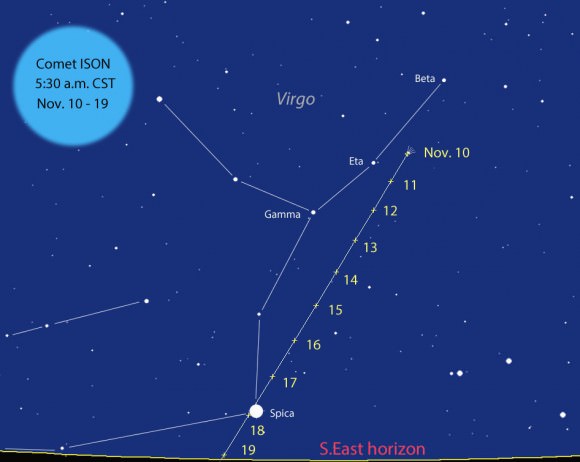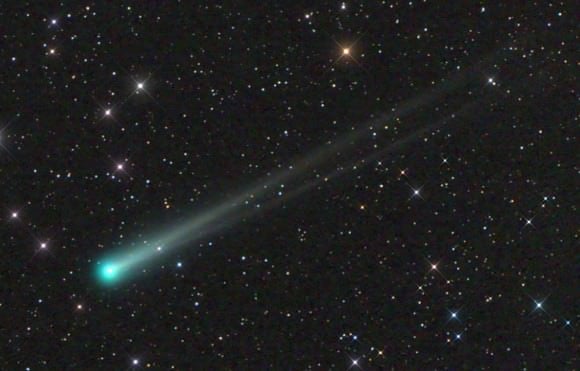Let the show begin! With all our reports and images of Comet ISON being in outburst, this latest image from astrophotographer Damian Peach shows just how much activity is taking place in this comet as it races towards the Sun. "Hard to believe this is the same comet in my last image of Nov 10th!" Damian said via email.
ISON's tail is suddenly full of streamers and features not seen before in this comet. At less than two weeks to its close encounter with the Sun on November 28, only a short amount of time will tell us if Comet ISON is just beginning to show off its brightness or if it is beginning to break apart.
The views here are through good quality telescopes. It is just now becoming visible to the naked eye, looking like a faint smudge at about magnitude +5.5.
Below is a "negative" view from Damain Peach, as well as a variety of views from Joseph Brimacombe and others that are coming in:
[caption id="attachment_106472" align="aligncenter" width="580"]
A widefield view of Comet ISON, taken from New Mexico Skies at 11h 59m UT on Nov. 15, 2013 using an FSQ 106 ED telescope and STL11K camera on a PME II mount. 1 x 10 min exposures. Credit and copyright: Joseph Brimacombe. [/caption]
[caption id="attachment_106474" align="aligncenter" width="580"]
A narrowfield, false color view of Comet ISON on Nov. 15, 2013, taken from New Mexico. Credit and copyright: Joseph Brimacombe. [/caption]
And an animation from Brimacombe:
[caption id="attachment_106467" align="aligncenter" width="580"]
A negative image of Comet ISON on Nov. 15, 2013, 106mm F5.0 with STL-11k. LRGB. L: 5x2mins. RGB: 1x2mins. Credit and copyright: Damian Peach.
[/caption]
[caption id="attachment_106449" align="aligncenter" width="580"]
Another view of Comet ISON this morning (Nov. 15) photographed by Leonid Elenin[/caption]
[caption id="attachment_106446" align="aligncenter" width="580"]
Spectacular photo of Comet ISON taken this morning Nov. 15 from Charleston, Rhode Island, USA showing the recent outburst. Click to enlarge. Credit: Scott MacNeill[/caption]
Check out a
simulator of how ISON will look
in the skies from Earth or see this map of how to see ISON for yourself:
[caption id="attachment_106417" align="aligncenter" width="580"]
If you haven't seen the comet yet, you can use this map to track it through the weekend as it zips quickly through Virgo. The map shows the sky facing southeast just before the start of morning twilight or about 100 minutes before sunrise. ISON should be plainly visible in binoculars in a dark sky. Created with Chris Marriott's SkyMap program[/caption]
And for comparison, here is Damian Peach's previous image from Nov. 10:
[caption id="attachment_106414" align="aligncenter" width="580"]
Comet ISON on Nov. 10 before the recent outburst with well-developed dust (upper) and gas tails. Click ot enlarge. Credit: Damian Peach[/caption]
 Universe Today
Universe Today


